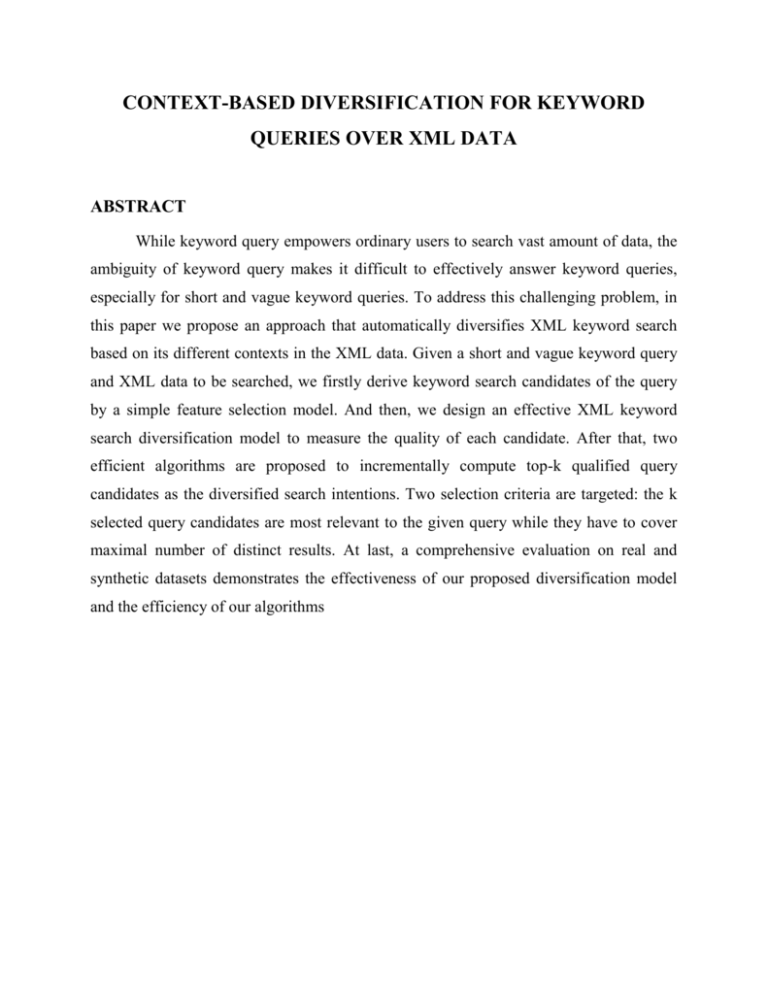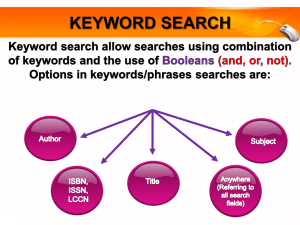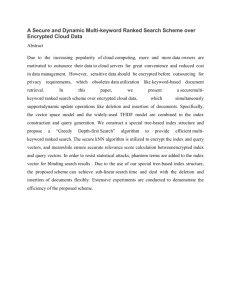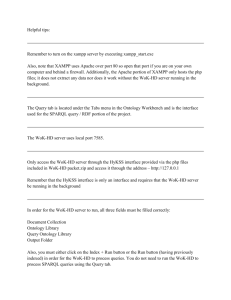Context-based Divers..
advertisement

CONTEXT-BASED DIVERSIFICATION FOR KEYWORD QUERIES OVER XML DATA ABSTRACT While keyword query empowers ordinary users to search vast amount of data, the ambiguity of keyword query makes it difficult to effectively answer keyword queries, especially for short and vague keyword queries. To address this challenging problem, in this paper we propose an approach that automatically diversifies XML keyword search based on its different contexts in the XML data. Given a short and vague keyword query and XML data to be searched, we firstly derive keyword search candidates of the query by a simple feature selection model. And then, we design an effective XML keyword search diversification model to measure the quality of each candidate. After that, two efficient algorithms are proposed to incrementally compute top-k qualified query candidates as the diversified search intentions. Two selection criteria are targeted: the k selected query candidates are most relevant to the given query while they have to cover maximal number of distinct results. At last, a comprehensive evaluation on real and synthetic datasets demonstrates the effectiveness of our proposed diversification model and the efficiency of our algorithms EXISTING SYSTEM Keyword search on structured and semi-structured data has attracted much research interest recently, as it enables users to retrieve information without the need to learn sophisticated query languages and database structure. Compared with keyword search methods in Information Retrieval (IR) that prefer to find a list of relevant documents, keyword search approaches in structured and semi-structured data concentrate more on specific information contents, e.g., fragments rooted at the smallest lowest common ancestor (SLCA) nodes of a given keyword query in XML In general, the more keywords a user’s query contains, the easier the user’s search intention with regards to the query can be identified. However, when the given keyword query only contains a small number of vague keywords, it would become a very challenging problem to derive the user’s search intention due to the high ambiguity of this type of keyword queries. Although sometimes user involvement is helpful to identify search intentions of keyword queries, a user’s interactive process may be time consuming when the size of relevant result set is large. To address this, we will develop a method of providing diverse keyword query suggestions to users based on the context of the given keywords in the data to be searched. By doing this, users may choose their preferred queries or modify their original queries based on the returned diverse query suggestions. PROPOSED SYSTEM We initiate a formal study of the diversification problem in XML keyword search, which can directly compute the diversified results without retrieving all the relevant candidates. Towards this goal, given a keyword query, we first derive the co-related feature terms for each query keyword from XML data based on mutual information in the probability theory, which has been used as a criterion for feature selection. The selection of our feature terms is not limited to the labels of XML elements. Each combination of the feature terms and the original query keywords may represent one of diversified contexts (also denoted as specific search intentions). And then, we evaluate each derived search intention by measuring its relevance to the original keyword query and the novelty of its produced results. To efficiently compute diversified keyword search, we propose one baseline algorithm and two improved algorithms based on the observed properties of diversified keyword search results. The remainder of this paper is organized as follows. We introduce a feature selection model and define the problem of diversifying XML keyword search. We describe the procedure of extracting the relevant feature terms for a keyword query based on the explored feature selection model. We propose three efficient algorithms to identify a set of qualified and diversified keyword query candidates and evaluate them based on our proposed pruning properties. We provide extensive experimental results to show the effectiveness of our diversification model and the performance of our proposed algorithms. We describe the related work in Section and conclude in Section PROPOSED SYSTEM ALGORITHMS The authors proposed efficient algorithms to identify keyword clusters in large collections of blog posts for specific temporal intervals ANCHOR-BASED PRUNING SOLUTION Although the anchor-based pruning algorithm can avoid unnecessary computation cost of the baseline algorithm, it can be further improved by exploiting the parallelism of keyword search diversification and reducing the repeated scanning of the same node lists. DATASET AND QUERIES We selected some terms based on the following criteria: A selected term should often appear in user-typed keyword queries; A selected term should highlight different semantics when it co-occurs with feature terms in different contexts. AVERAGE TIME COST OF QUERIES That in about 3.5 seconds and 2 seconds, respectively. This is because lots of nodes can be skipped by anchor nodes without computation. Another reason is that when the number of suggestions is small, e.g., 5, we can quickly identify the qualified suggestions and safely terminate the evaluation with the guarantee of the upper bound. As such, the qualified suggestions and their diverse results can be output. BASELINE SOLUTION Different from traditional XML keyword search, our work needs to evaluate multiple intended query candidates and generate a whole result set, in which the results should be diversified and distinct from each other. Therefore, we have to detect and remove the duplicated or ancestor SLCA results that have been seen when we obtain new generated results. ADVANTAGES The first work to measure the difference of XML keyword search results by comparing their feature sets. However, the selection of feature set in is limited to metadata in XML and it is also a method of post-process search result analysis. Therefore, the simple measure can be used to quantify how much the observed word cooccurrences maximize the dependency of feature terms while reduce the redundancy of feature terms. After that, all the generated term pairs will be recorded in the term correlated graph. In the procedure of building correlation graph, we also record the count of each term-pair to be generated from different entity nodes. As such, after the XML data tree is traversed completely, we can compute the mutual information score for each term-pair based on Equation. To reduce the size of correlation graph, the term-pairs with their correlation lower than a threshold can be filtered out. Based on the off-line built graph, we can on-the-fly select the top-m distinct terms as its features for each given query keyword. SAMPLE ARCHITECTURE HARDWARE REQUIREMENTS: System : Pentium IV 2.4 GHz. Hard Disk : 40 GB. Floppy Drive : 1.44 Mb. Monitor : 14’ Colour Monitor. Mouse : Optical Mouse. Ram : 512 Mb. SOFTWARE REQUIREMENTS: Operating system : Windows 7 Ultimate. Coding Language : ASP.Net with C# Front-End : Visual Studio 2010 Professional. Data Base : SQL Server 2008.







